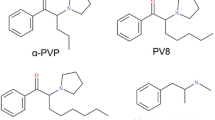Summary
The action of m-trifluoromethylphenylpiperazine (TFMPP) and m-chlorophenylpiperazine (m-CPP), inhibiting the exploratory activity (ambulation and peeping) of the rat was studied in the open field test. The effects of both these drugs were antagonized by mesulergine, metergoline and mianserin, and partly by methysergide. Spiperone showed an antagonistic action in one (mean) dose only. The effects of TFMPP and m-CPP were not antagonized by ipsapirone, gepirone, cyanopindolol, compound 21009, cyproheptadine, ritanserine, ICS 205930, idazoxan or atropine. The lesion produced by p-chloramphetamine attenuated the effects of TFMPP and abolished those of m-CPP. The obtained results permit an assumption that the TFMPP- and m-CPP-induced decrease in the exploratory activity is mediated probably by 5-HT1C receptors.
Similar content being viewed by others
References
Asarch KB, Ransom RW, Shih JS (1985) 5-HT1A and 5-HT1B selectivity of two phenylpiperazine derivatives: evidence for 5-HT1B heterogeneity. Life Sci 36: 1265–1273
Cuningham KA, Callahan PM, Appel JB (1987) Discriminative stimulus properties of 8-hydroxy-2-(di-n-propylamino)tetralin (8-OHDPAT): implications for understanding the actions of novel anxiolytics. Eur J Pharmacol 138: 29–36
Engel G, Göthert M, Hoyer D, Schlicker E, Hillenbrandt K (1986) Identity of inhibitory presynaptic 5-hydroxytryptamine (5-HT) autoreceptors in the rat brain cortex with 5-HT1B binding sites. Naunyn Schmiedebergs Arch Pharmacol 332: 1–7
Glennon RA, Pierson ME (1987) The stimulus effects of 1-3-(tri-fluoromethyl)phenyl piperazine (TFMPP) may involve both a 5-HT1B and 5-HT1C mechanism. International conference under auspices European Behavioural Pharmacology Society, Amsterdam, November 24–27, 1987; abstracts, p 93
Hamon M, Cossery JM, Spampinato V, Gozlan H (1986) Are there specific ligands for 5-HT1A and 5-HT1B receptor binding sites in the brain? Trends Pharmacol Sci 7: 336–338
Hoyer D, Engel G, Kalkman HO (1985) Characterization of the 5-HT1B recognition site in rat brain: binding studies with (−)125I iodocyanopindolol. Eur J Pharmacol 118: 1–12
Janssen PAJ, Jagenau AHM, Schellekens KHC (1960) Chemistry and pharmacology of compounds related to 4-(4-hydroxy-4-phenylpiperidino)-butyrophenone. Part IV. Influence of haloperidol (R-1625) and chloropromazine on the behaviour of rats in a unfamiliar open field situation. Psychopharmacology 1: 389–392
Kennett GA, Gurzon G (1987) Behavioural effects of 5-HT1B and 5-HT1C receptor stimulation. International conference under auspices European Behavioural Pharmacology Society. Amsterdam, November 24–27, 1987; abstracts, p 75
Lucki I, Frazer A (1982) Behavioral effects of indole and piperazine-type serotonin receptor agonist. Soc Neurosci 8: 101
Maj J, Chojnacka-Wójcik E, Kŀodzińska A, Dereń A, Moryl E (1988) Hypothermia induced by m-trifluoromethylphenylpiperazine or m-chlorophenylpiperazine: an effect mediated by 5-HT1B receptors? J Neural Transm 73: 43–55
Maj J, Chojnacka-Wójcik E, Tatarczyńska E, Kŀodzińska A (1987) Central action of ipsapirone, a new anxiolytic drug, on serotoninergic, noradrenergic and dopaminergic functions. J Neural Transm 70: 1–17
Maj J, Lewandowska A (1980) Central serotonin-mimetic action of phenylpiperazines. Pol J Pharmacol Pharm 32: 495–504
Middlemiss DN, Fozard JR (1983) 3-Hydroxy-2-(di-n-propylamino)-tetralin discriminates between subtypes of the 5-HT1 recognition site. Eur J Pharmacol 90: 151–153
Poroutka SJ (1986) Pharmacological differentiation and characterization of 5-HT1A, 5-HT1B, and 5-HT1C sites in rat frontal cortex. J Neurochem 47: 529–540
Richardson BP, Engel G (1986) The pharmacology and function of 5-HT3 receptors. Trends Pharmacol Sci 9: 424–428
Rowan MJ, Anwyl R (1986) Neurophysiological effects of buspirone and ipsapirone in the hippocampus: comparison with 5-hydroxy-tryptamine. Eur J Pharmacol 132: 93–96
Samanin R, Mennini T, Ferraris A, Bendotti C, Borsini F, Garattini S (1979) m-Chlorophenylpiperazine: a central serotonin agonist causing powerful anorexia in rats. Naunyn Schmiedebergs Arch Pharmacol 308: 159–163
Sills MA, Wolfe BB, Frazer A (1984) Determination of selective and nonselective compounds for 5-HT1A and 5-HT1B receptor subtypes in rat frontal cortex. J Pharmacol Exp Ther 231: 480–487
Smith LM, Peroutka SJ (1986) Differential effects of 5-hydroxy-tryptamine1A selective drugs on the 5-HT behavioral syndrome. Pharmacol Biochem Behav 24: 1513–1519
Author information
Authors and Affiliations
Rights and permissions
About this article
Cite this article
Kŀodzińska, A., Jaros, T., Chojnacka-Wójcik, E. et al. Exploratory hypoactivity induced by m-trifluoromethylphenylpiperazine (TFMPP) and m-chlorophenylpiperazine (m-CPP). J Neural Transm Gen Sect 1, 207–218 (1989). https://doi.org/10.1007/BF02248670
Received:
Accepted:
Issue Date:
DOI: https://doi.org/10.1007/BF02248670




